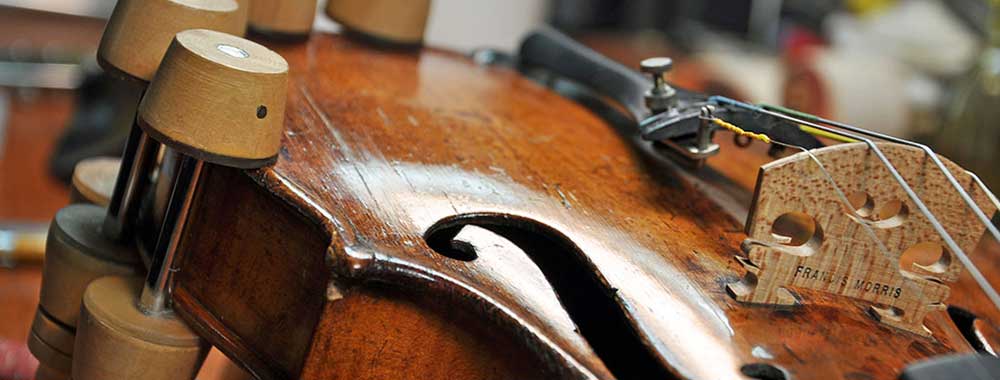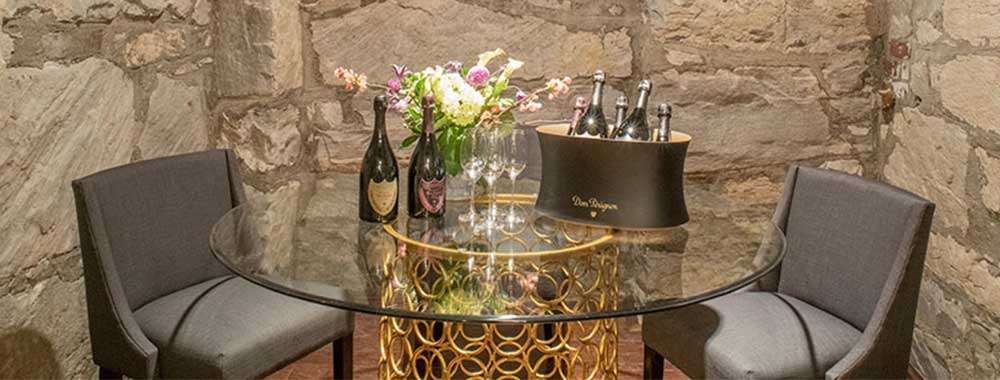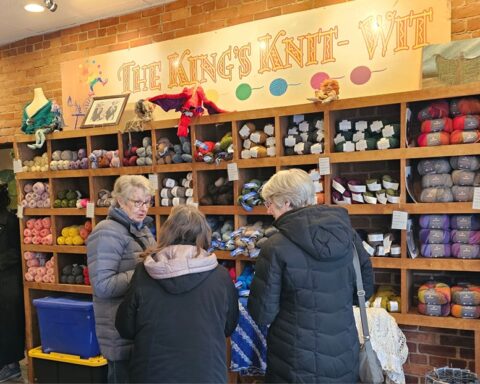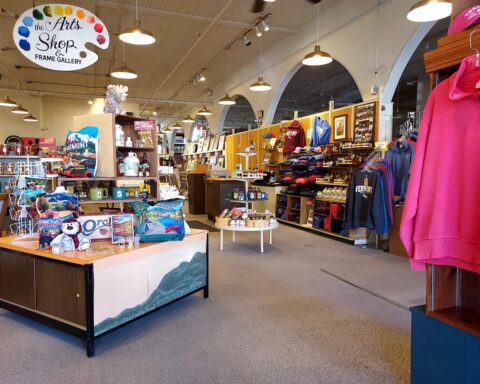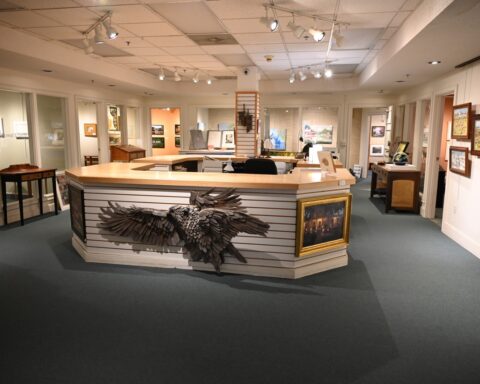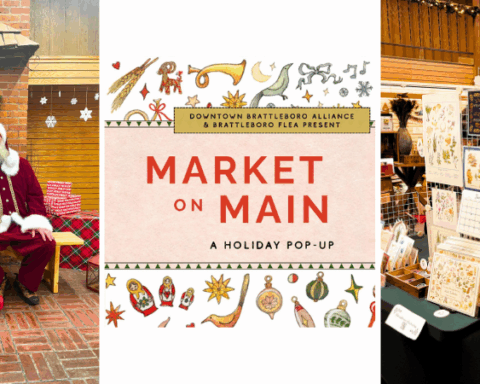Francis Morris practices a rare craft

By Judith Ensign
We see violins on the stages of Tanglewood and other concert halls in Berkshire County. They’re the workhorses of symphony orchestras, treasures of chamber music, partners of virtuoso soloists. We hear them in all kinds of music, from rock to country to classical. What seems inconceivable is that something so beautiful started life as a wedge of wood, waiting for a craftsman to turn it into something extraordinary.
The story of the violin began in mid-16th-century Cremona, in northern Italy, where an instrument maker by the name of Andrea Amati developed the basic framework of what is now considered the modern violin. He and other instrument makers in Cremona obtained wood for their violins from trees in the Dolomites, the forests of northern Italy. Legend holds that these early makers thought the forests were magical: a cathedral of tall trees that produced singing wood.
Of the thousands of instruments made in Cremona from 1550 to 1750, a great many are elegantly designed works of art, known today for superior tone, beauty and multimillion-dollar price tags. Their composition is so perfect that, down through the centuries, violin-makers have made only minor adjustments to Amati’s models, to give a greater range of notes to players and allow for the stronger, brilliant tone needed in today’s large concert halls.
Violin-making is a rare craft. There are fewer than 300 makers in the United States, and Berkshire County has been favored with one such artisan, Francis Morris. Morris studied for a career as a cellist but was introduced to instrument-making while still in high school. He knew right away that the combination of making instruments and music was perfect for him. After graduating from a renowned violin-making school in Mittenwald, Germany, he apprenticed with makers in Switzerland and California. In 1984 he opened his own workshop in Great Barrington and joined the ranks of those dedicated artisans who devote their lives to making and restoring string instruments.

Tucked away in a rural area, Morris’ comfortable workshop has an 18th-century feel. Violins and violas hang from hooks high on the walls, and cellos are lined up around the edge of the room. A few instruments are in pieces on workbenches, sharing space with a large collection of hand tools, pots and brushes. Instrument cases are stacked in the corners, and bows are tucked here and there, waiting for repairs.
Today, creating a string instrument is still the same highly complex and exacting work as it was five centuries ago. Morris, like most makers, copies instruments made by craftsmen of 17th- and 18th-century Cremona.
“At some time in the future I may design my own model,” he said, “but for now I follow the blueprints of those who preceded me.”
One of his first steps is acquiring the best wood.
“We try to make instruments of wood that is as light and stiff as possible because it helps to make a lively sound that carries in a concert hall,” he said. “For violins, if the wood is heavy and flexible, the weight and flexibility tend to mute them. I use wood from Yugoslavia, maple for the back and spruce for the top of my instruments.
“About the earliest you want to use spruce is in two years and possibly seven for maple. After the initial drying period, wood, especially spruce, starts to change in quality from being a flexible, slightly sappy, sweet-smelling and translucent material to a stiffer, lighter, less translucent one. The further in time spruce gets from being part of a living tree, the better it is suited for being the main resonating surface of man’s most complex musical instrument.”

The process of building a beautiful instrument can’t be rushed and requires infinite patience.
“It takes me approximately 250 hours to make a violin, a long time,” Morris said “If you do the math, it means I might only complete two or three instruments each year.”
The violin-making tools Morris uses are replicas of tools developed by 16th-century makers. Using a pattern, he cuts the wood into the pieces needed and then spends many hours planing it. The shavings are very thin, and large piles climb up from the floor.
“My cat used to love to play in the piles of shavings,” he said. “It was fun to watch him chase after them.”
To further shape the back and top pieces of the instrument, Morris uses various sizes of gouges. Hunched over a table, he guides them through the wood, switching to a smaller thumb plane for arching the top. Using a caliper, he continually measures the wood’s thickness. Asked if he ever shaved off too much wood, he laughed and said not since his student days.
“I’m well aware that a small error in the thickness of wood can change the sound of the final product. Every millimeter counts, so I’m very careful.”
After many weeks of sculpting and fitting together the individual pieces, one of the last steps is to apply varnish.
According to Morris, “During the long process of making a violin, makers often sit back and imagine how beautiful the violin will look when varnished. It’s one of the things that keeps us going, trying to match the beauty of the classical Cremonese varnish.
“There is not a maker out there who has not spent thousands of dollars on natural resins and colors and countless hours cooking them to find the right combination. When we come close, which we have, it’s an awe-inspiring moment to see the glow in the wood come up through the soft colors and varnish and linger there, as if to say: ‘Now that wasn’t so hard, was it?’”
Although at first look a violin might appear to have only a few parts, that isn’t quite true. Most instruments are constructed of 30 or more pieces.
Many of these are inside the instrument and are used for strengthening and improving the tone. There are people who claim that it takes 100 years or more for all of those parts to become acquainted with each other and come alive to produce beautiful music. Morris disagrees.
“After they have been played for a few months, most new instruments will settle down into a full, sweet sound,” he said. “I know that with age they will continue to improve.”
Morris and his shop foreman, Michael Anthony Daddona, set aside two days a week for working on their new instruments.
“I work hard to meet the high standards Francis sets,” Daddona said. “Like Francis, I also get inspiration from the harmony of design found in the instruments of classical Cremona, but I also like that I can be flexible in my work.”

When asked about the players who purchase his instruments, Morris said, “I get commissions from all kinds of musicians: professional soloists, orchestral players, even conservatory students. However, I usually recommend that parents consider renting a violin for small children, at least when they are starting lessons.
“The violin is a pretty popular instrument, but it’s also difficult to learn. It takes a long time before kids begin to make pleasant sounds.”
The life of a violin-maker’s workshop also involves other functions. Many new and old instruments and bows are for sale, and Morris’ shop provides a wonderful space furnished with a grand piano for giving these a try. Renting an instrument is also an option, and both makers repair instruments brought to them.
“During the summer, I get many 911 calls, especially from Tanglewood students and faculty. Even [famous cellist] Yo-Yo Ma has needed my help,” said Morris. “Accidents do happen, and part of being a maker means undertaking last-minute repairs.”
There are hundreds of thousands of violins in the world, but it’s doubtful that any one instrument is exactly like any other. No two pieces of wood are the same. There are tiny variations in density and thickness and differences in the way each maker works. Ingredients in varnish, choice of glue, even the kind of strings used, all make for different qualities of tone. Although the violin makers of 500 years ago didn’t leave us any instructions, each instrument stores the history of its maker’s intentions.
As yet, no one has been able to definitively answer the question of why the instruments made by Amati, Stradivari, Guarneri and other Cremonese masters are so exceptional. Some people believe there are secrets yet to be learned about how those makers worked, but perhaps there are no secrets.
There are certainly violin makers today who are equally as talented as were the masters of the Renaissance. It’s quite possible that in 200 or 300 years Francis Morris’ violins will also achieve immortality. •
Francis Morris Violins
65 Pumpkin Hollow Road, Great Barrington, Mass. 413-528-0165 francismorrisviolins.com
During the summer, Francis Morris teaches for the Violin Craftsmanship Institute at the University of New Hampshire, and Michael Anthony Daddona assists with those workshops. They are training the next generation of makers.
Judith Ensign is retired from higher education administration. Originally trained as a violinist, she hasplayed with chamber and orchestral groups for many years. She now lives in Williamstown, MA, where sheis enjoying her latest interest: writing.
